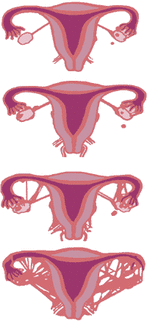What is Endometriosis?
|
|
Endometriosis (en-doe-me-tree-O-sis) is an often painful disorder in which tissue that normally lines the inside of the uterus — the endometrium — grows outside the uterus (endometrial implant).
In endometriosis, displaced endometrial tissue continues to act as it normally would — it thickens, breaks down and bleeds with each menstrual cycle. Because this displaced tissue has no way to exit the body, it becomes trapped. When endometriosis involves the ovaries, cysts or non-cancerous tumors called endometriomas may form. Surrounding tissue can become irritated, eventually developing scar tissue and adhesions — abnormal tissue that binds organs together. Endometriosis can cause pain — sometimes severe — especially during a female's menstrual cycle. Fertility problems also may develop. -MayoClinic |
Common SymptomsCommon Symptoms
|
Stages of Endometriosis
|

